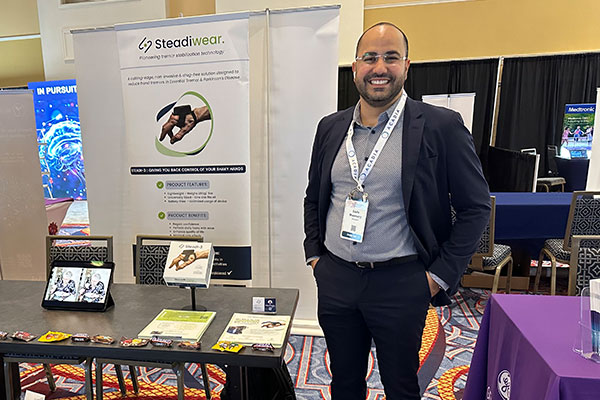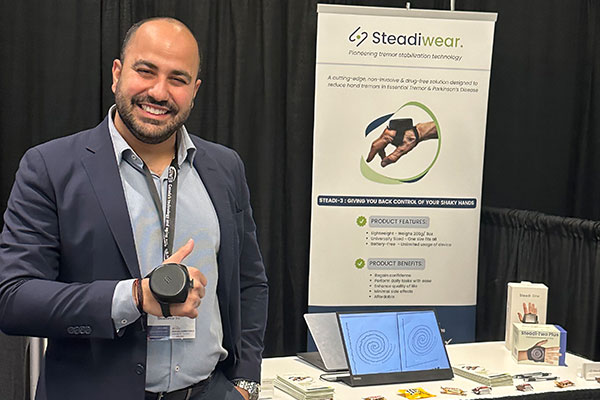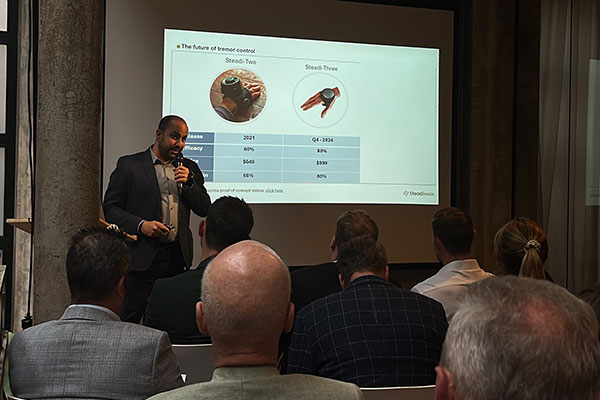Emile Maamary’s Steadiwear Glove Reduces Hand Tremors

Emile Maamary, MBA ’23, cofounder and chief marketing officer of Steadiwear, at the Advanced Therapeutics in Movement & Related Disorders Congress, Washington, D.C., June 2025
Hand tremors caused by essential tremor and Parkinson’s disease make everyday tasks such as getting dressed, drinking, and writing anywhere from difficult to impossible. Seeing how the condition impacted their own family members, Emile Maamary, MBA ’23, and his cofounder, Mark Elias, decided to do something about it by developing a wearable device that reduces hand tremors and launched Steadiwear to make it widely available.
Maamary, Steadiwear’s chief marketing officer, credits the Cornell Executive MBA Americas program at the Samuel Curtis Johnson Graduate School of Management for enabling him to make key contacts and gain advanced skills to hone the startup’s marketing strategy and take it to the next level.
Learn more about Maamary and Steadiwear in this Q&A.
Q: What does Steadiwear do? What problem or opportunity does it address?
Maamary: Steadiwear develops wearable stabilization devices that reduce hand tremors caused by essential tremor and Parkinson’s disease. Our core innovation is a sleek, battery-free glove that is now in its third generation and delivers instant, non-invasive tremor control. With over 36 million people globally suffering from tremors and few effective, accessible solutions, we’re addressing a massive unmet need in neurology and mobility care.
Q: What inspired you to launch Steadiwear?
Maamary: Both my cofounder, Mark Elias, and I had family members affected by tremors. That personal connection transformed into a professional mission to create a technology that could restore independence for people living with this condition. What started as a passion project quickly evolved into a serious commercial venture once we saw the clinical potential and overwhelming patient demand.
Q: What stage are you at in financing your startup?
Maamary: To date, we’ve raised $2.8M from grants, angels, and strategic investors. We’re closing a seed round at a $7M pre-money valuation. These funds will support the launch of our next-gen device (Steadi-3), expand our geographic footprint, and complete Medicare coverage testing.

Q: What are some of the most memorable moments in your startup journey?
Maamary: I’ll never forget the first time a tremor patient tried our glove and could apply eyeliner for the first time in 30 years. It sounds simple, but for them, it was transformative. Another proud moment was signing our first distribution deal in the U.S. for veterans. Both moments validate that our solution has clinical and commercial credibility.
Q: What obstacles did you face and overcome in your startup journey?
Maamary: Convincing stakeholders that a passive, battery-free solution could outperform legacy devices was not easy. We faced skepticism, limited capital, and early product iterations that didn’t meet our standards. However, persistence paid off as we have now validated 84 percent efficacy with our latest device and developed a business model that clinics can easily adopt.
Q: Did you draw on any Cornell resources to help develop Steadiwear or take it to the next level?
Maamary: Absolutely. The Cornell Executive MBA Americas program played a significant role. I connected with other founders who were building in the wearables space and even joined their team as an advisor. I was also connected to over 20 investors through Cornell’s entrepreneurial ecosystem, and the mentorship of medtech alumni gave me the confidence and tools to navigate complex funding and go-to-market strategies.

Q: Is there any particular Johnson School faculty member who influenced your thinking or approach as an entrepreneur?
Maamary: Yes, I had the pleasure of having my marketing professor, Manoj K. Thomas [Demir Sabanci Professor of Marketing and Management and associate dean of NYC initiatives], assess my go-to-market strategy. He also helped me with market sizing. I still draw inspiration from our discussions whenever I review our total accessible market, serviceable addressable market, and serviceable obtainable market calculations. These exercises have really refined how we approach the marketing spend and they have allowed us to show off our maturity with investors when pitching.
Q: What are the most valuable things you learned at Cornell that helped as you worked to develop Steadiwear? And what’s most helpful now, in running and marketing your business?
Maamary: Cornell taught me to think in systems, balancing clinical innovation with reimbursement mechanics, user experience with regulatory alignment. The most helpful lesson today is how to simplify complexity. Whether pitching to investors or training physicians, clarity drives adoption. That’s been critical for scaling Steadiwear.
Q: What advice do you have for other aspiring entrepreneurs?
Maamary: Start with a problem you deeply care about and stay obsessed with solving it better than anyone else. Validate quickly, iterate even faster, and don’t wait for perfection. The path won’t be linear, but the impact and traction will follow if you keep patient needs at the center.
